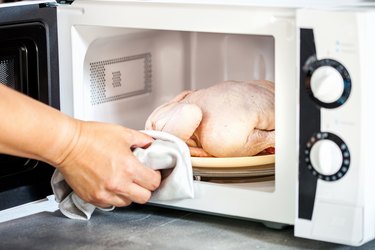
If you've got a freezer full of meats that somehow need to transform into this week's dinner, know that defrosting it doesn't have to be complicated.
Before you reach into the freezer and begin the big thaw, make sure you aren't inadvertently making mistakes that may mess up your meat's freshness and put your health at risk.
Video of the Day
Video of the Day
Below, find two of the most common meat thawing traps to avoid, plus safer defrosting strategies you should use instead.
1. You Thaw It on the Kitchen Counter
If defrosting meat at room temperature is your go-to thawing technique, listen up.
"Meat (and all perishable foods) should never be thawed on the counter and must not be left at room temperature for more than two hours," dietitian and chef Julie Harrington, RD, tells LIVESTRONG.com.
And for warmer environments, where temps reach 90 degrees Fahrenheit or above, food shouldn't be outside a fridge for more than one hour, according to the U.S. Department of Health & Human Services.
"That's because as soon as the perishable item begins to thaw and becomes warmer than 40 degrees Fahrenheit, bacteria may be present and begin to multiply rapidly," Harrington explains.
Indeed, harmful bacteria like staph, salmonella, E. coli and campylobacter that cause foodborne illnesses flourish in temperatures between 40 and 140 degrees Fahrenheit, per the USDA.
Dubbed the "danger zone," the number of pesky pathogens can double in only 20 minutes when temps fall within this range.
To avoid this unsafe situation, also never thaw foods in a garage, basement, car or outdoors.
2. You Submerge It in Hot Water
When you've forgotten to take the meat out of the icebox and you're in a hurry, you might think that thawing it in hot water is a feasible fast fix.
"This may seem like it'll speed things along, but you should not defrost meat in hot water because the exterior will heat up much faster than the interior," Harrington says.
In other words, the outer layer can reach the temperature danger zone and be at risk for bacteria and toxins accumulating at harmful levels — even if the center of the perishable item may still be frozen, she explains.
How to Defrost Meat the Right Way
1. In the Refrigerator
"The best way to thaw meat safely is to plan ahead," Harrington says. This means slowly defrosting your meat in the fridge.
While most foods need a day or two to thaw in the refrigerator, you can defrost smaller items overnight. Conversely, larger pieces of meat such as whole turkeys will require more time — for every 5 pounds of weight, you'll need approximately one thawing day, according to the USDA.
"After thawing, ground meat, poultry and seafood should keep well in the refrigerator for an extra day or two, while red meat like beef, pork, lamb and steak stays fresh for three to five more days," Harrington says.
And always place your meats on the bottom shelf in the fridge.
"If juices drip, which can happen, you may contaminate your other food," she adds. Doing so can help keep you safe from possible food poisoning or other foodborne illnesses.
2. In Cold Water
While thawing in hot water is a bad idea, defrosting in cold tap water is completely safe.
Simply place the meat in a leak-proof bag, removing as much air as possible, and fully submerge it in a large bowl of cold water. The USDA recommends changing the water every 30 minutes as the meat continues to thaw.
And, though it depends on how much meat you're defrosting, this cold-water thawing process can be a timesaver compared to the defrost-in-the-fridge method.
"A one-pound package of meat can thaw in an hour or less whereas packages of three to four pounds can take more than two hours," she says.
3. In the Microwave
In some scenarios, nuking frozen meat may be a quick, convenient option. "This method only really works for smaller cuts," Harrington says.
If your microwave has a defrost setting that can regulate the temperature for specific cuts of meat, use it. "If not, set your microwave at a lower power level and heat in short bursts until the meat is thawed," Harrington recommends.
And always cook immediately after microwave-thawing since some spots of the meat may become warm — and even cook during the defrosting process — possibly creating danger-zone temperatures, per the USDA.
4. Cooking Without Thawing
What if you want to skip the big thaw altogether? It's possible — and safe — to cook frozen foods without defrosting at all.
But keep in mind that this cooking method will take "approximately 50 percent longer than the recommended time for fully thawed or fresh meat and poultry," according to the USDA.
Was this article helpful?
150 Characters Max
0/150
Thank you for sharing!
Thank you for your feedback!